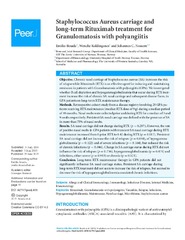Staphylococcus Aureus carriage and long-term Rituximab treatment for Granulomatosis with polyangiitis
Permanent link
https://hdl.handle.net/10037/8686Date
2015-06-25Type
Journal articleTidsskriftartikkel
Peer reviewed
Abstract
Methods. Retrospective cohort study from a disease registry involving 29 GPA patients receiving RTX maintenance (median RTX dose of 9 g) during a median period of 49 months. Nasal swabs were collected prior and during RTX for a median of 3 and 9 swabs respectively. Persistent SA nasal carriage was defined with the presence of SA in more than 75% of nasal swabs.
Results. SA nasal carriage did not change during RTX (p = 0.297). However, the rate of positive nasal swabs in GPA patients with transient SA nasal carriage during RTX maintenance increased from 0 prior RTX to 0.42 during RTX (p = 0.017). Persistent SA nasal carriage did not increase the risk of relapses (p = 0.844), of hypogammaglobulinemia (p = 0.122) and of severe infections (p = 0.144), but reduced the risk of chronic infections (p = 0.044). Change in SA carriage status during RTX did not influence the risk of relapses (p = 0.756), hypogammaglobulinamia (p = 0.474) and infections, either severe (p = 0.913) or chronic (p = 0.121).
Conclusion. Long-term RTX maintenance therapy in GPA patients did not significantly influence SA nasal carriage status. Persistent SA carriage during long-term RTX treatment did not seem to increase the risk of relapses, but seemed to decrease the risk of hypogammaglobulinemia associated chronic infections.


 English
English norsk
norsk